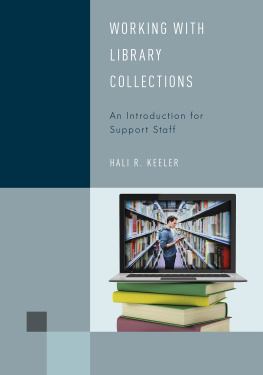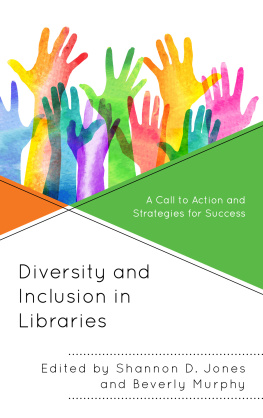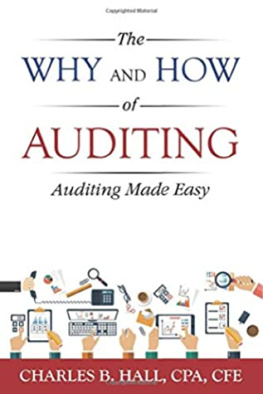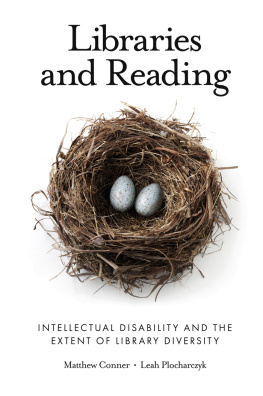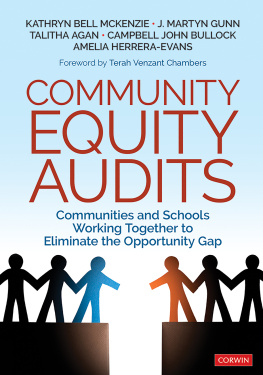AUDITING DIVERSITY IN LIBRARY COLLECTIONS
Sarah Voels
Foreword by Rosalind Washington

Copyright 2022 by Sarah Voels
All rights reserved. No part of this publication may be reproduced, stored in a retrieval system, or transmitted, in any form or by any means, electronic, mechanical, photocopying, recording, or otherwise, except for the inclusion of brief quotations in a review, without prior permission in writing from the publisher.
Library of Congress Cataloging-in-Publication Data
Names: Voels, Sarah, author. Title: Auditing diversity in library collections / Sarah Voels.
Description: Santa Barbara, California : Libraries Unlimited, [2022] | Includes index.
Identifiers: LCCN 2022010023 (print) | LCCN 2022010024 (ebook) | ISBN 9781440878749 (paperback ; acid-free paper) | ISBN 9781440878756 (ebook)
Subjects: LCSH: Collection development (Libraries)United StatesAuditing. | Libraries and minoritiesUnited States. | BISAC: LANGUAGE ARTS & DISCIPLINES / Library & Information Science / Collection Development | LANGUAGE ARTS & DISCIPLINES / Library & Information Science / Digital & Online Resources
Classification: LCC Z687.2.U6 V64 2022 (print) | LCC Z687.2.U6 (ebook) | DDC 025.2/1dc23/eng/20220504
LC record available at https://lccn.loc.gov/2022010023LC ebook record available at https://lccn.loc.gov/2022010024
ISBN: 978-1-4408-7874-9 (paperback)
978-1-4408-7875-6 (ebook)
26 25 24 23 22 1 2 3 4 5
This book is also available as an eBook.
Libraries Unlimited
An Imprint of ABC-CLIO, LLC
ABC-CLIO, LLC
147 Castilian Drive
Santa Barbara, California 93117
www.abc-clio.com
This book is printed on acid-free paper 
Manufactured in the United States of America
Contents
Foreword
The people and communities that we serve deserve to have books, services, and resources that reflect not only their lives but their current economic and societal information needs. Communities are constantly changing, and it is the librarys responsibility to make sure we are adjusting our practices to meet our customers needs. Sarah Voelss research on auditing diversity in library collections serves as a guide for developing a practice to ensure our resources reflect the communities that we serve. Providing equal access to all library customers is an essential component of every librarys mandate. However, there are systemic barriers that inhibit marginalized populations from having equitable access to library resources and services. Next, I share personal examples that relate to Sarahs work on how these systemic barriers can inhibit equitable access to resources and services in libraries.
Before getting my start in public libraries as a community and neighborhood branch manager in 2018, I worked for six years in academic libraries and almost four years in school libraries, and I worked with a nonprofit I founded in 2017, iLibrary Experience, which ensured that disadvantaged students would have equitable access to school library experiences. Advocating and developing initiatives, programs, and services to push equity and inclusion within libraries has been a constant throughout my span of 13 years in libraries. In each role, I have consistently worked in spaces where my customer base was majority Black and Hispanic with socioeconomic challenges. I often found myself in situations where strategic advocacy was needed to ensure equitable services and resources were available for my customer base. My passion and continuous dedication to this issue led to me receiving a Library State Technology Act (LSTA) grant to create a coworking space (Library Entrepreneur Research Hub) for a historically Black college or university (HBCU) library in Charlotte, North Carolina. This space provided students and marginalized residents access to technology, ideation workshops, free business consultation sessions, and a new collection of business and leadership books by Black and minority authors. The combination of my different avenues of work led me to start Library Social Capital, a consulting firm to assist with leadership and equity challenges in libraries.
I worked as a high school librarian (media specialist) at a science, technology, engineering, and math (STEM) magnet (low socioeconomic) school whose student population was 89 percent Black and 7 percent Hispanic, with the remainder white and Asian. The previous librarian retired after being in the position for 10 years. Circulation in the library was nonexistent outside of required checkouts from class assignments. The collection of 7,048 books was outdated, with an average age of 2004 in 2013. According to American Library Association (ALA) standards, a highly effective school library program should have a minimum of 15 to 20 books per child, and I had 4 books per child for the 1,626 student population. This means that if you were born into a family whose annual income is less than that of 80 percent of the population, you only have a 5.4 percent chance to make it out of poverty.
I advocated to the principal for the students to have access to the library before school, during lunch, during the day, and after school. I shifted the culture my first year by surveying and asking students about their interests and avoiding conversations about checking out books. The surveys I created asked if students had previous library instruction, internet access at home, computers at home, a history with checking out books, and if they had books at home. I learned that over 80 percent of my students never had formal library instruction, had no Wi-Fi/technology access at home, and had not checked out books regularly since elementary school. Most students did not have books at home. My findings left me disheartened and at a loss, knowing some students were moving forward to college with limited knowledge of how to locate scholarly resources.
I learned that students were interested in the sneaker culture, music industry, popular sci-fi, urban fiction, and books on entrepreneurship. My plan was to purchase books based on their interests. The district allotted each library a core collection of books and a county budget based on each schools population. I was given $1,800 to spend for 1,626 students. I used the funds to purchase books based on student interest, but I noticed challenges with finding books of interest from the approved district vendor list (publishing companies). Despite the challenges, I noticed an immediate increase in circulation from books I was able to purchase. I never did an official diversity audit of the collection, but I did an assessment based on student interest. After my first year working at the school, the leadership changed. The school gained a new principal, and she had different viewpoints on the library based on her experience from former schools she managed. To the leadership team, open access meant students skipping class, too much leisure, and disruptions in the hallways. This viewpoint was challenging for me because I spent a few months training at an affluent high school in Charlotte, which had trusting open-access policies for their students, who behaved no differently.
I unfortunately had to close the library doors for a six-month period because of assumed behavioral issues. The school leadership did not see the importance of students having access because their assumption was that students did not take the library seriously. Instead, the principal found other tasks for me, like assisting with the launch of new photo identification cards for students and assisting with ACT prep. The library became a holding space for make-up testing and professional development for teachers. I had to strategically advocate for students with data by showing the disparities of library access and staffing among affluent majority white vs. Black schools in the Charlotte area. Through my research, I found that students who attended affluent and private schools had open-access visitation policies and four or more librarians staffed for one school. I showed the difference in circulation statistics, accessibility, and additional funding opportunities from the parent-teacher association (PTA) boards.
Next page

